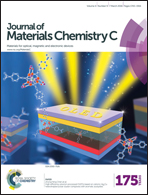Towards stable deep-blue emission and low efficiency roll-off in OLEDs based on phenanthroimidazole dimers†
Abstract
In this paper, two novel deep-blue emitters, mm-BPPI and mm-CN-BPPI, were obtained by coupling two 1,2-diphenyl-1H-phenanthro[9,10-d]imidazole (PPI) blocks in a meta–meta pattern and using a central benzene moiety as the bridge. Owing to this meta–meta connection, the dimer conjugation degree of mm-BPPI was effectively limited, and thus mm-BPPI exhibited very similar photophysical and electrochemical properties as PPI. However, the thermal stability of mm-BPPI was improved successfully, overcoming the defects of PPI for practical applications. Non-doped optimized devices fabricated with mm-BPPI exhibited stable deep-blue emission with CIE coordinates of (0.156, 0.050). After inserting cyano groups, higher glass-transition temperature and a quasi-reversible redox process were observed in mm-CN-BPPI; moreover, the lower efficiency roll-off was realized in its non-doped devices. This study demonstrates a strategy towards stable deep blue emitters with higher stability, better efficiency and lower roll-off ratio by chemical modification (meta–meta coupling or cyano group insertion) in non-doped deep-blue-emitting devices based on aryl-substituted phenanthroimidazole blocks.


 Please wait while we load your content...
Please wait while we load your content...